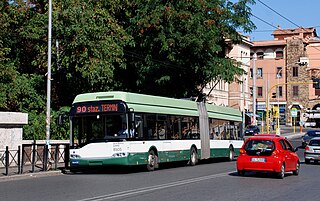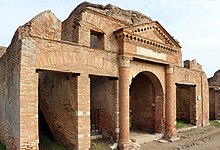
A Roman villa was typically a farmhouse or country house in the territory of the Roman Republic and the Roman Empire, sometimes reaching extravagant proportions.

Ancient Roman architecture adopted the external language of classical ancient Greek architecture for the purposes of the ancient Romans, but was different from Greek buildings, becoming a new architectural style. The two styles are often considered one body of classical architecture. Roman architecture flourished in the Roman Republic and to an even greater extent under the Empire, when the great majority of surviving buildings were constructed. It used new materials, particularly Roman concrete, and newer technologies such as the arch and the dome to make buildings that were typically strong and well engineered. Large numbers remain in some form across the former empire, sometimes complete and still in use today.

A warehouse is a building for storing goods. Warehouses are used by manufacturers, importers, exporters, wholesalers, transport businesses, customs, etc. They are usually large plain buildings in industrial parks on the outskirts of cities, towns, or villages.

A serapeum is a temple or other religious institution dedicated to the syncretic Greco-Egyptian deity Serapis, who combined aspects of Osiris and Apis in a humanized form that was accepted by the Ptolemaic Greeks of Alexandria. There were several such religious centers, each of which was called a serapeion/serapeum or poserapi, coming from an Egyptian name for the temple of Osiris-Apis.

Civitavecchia is a city and comune of the Metropolitan City of Rome in the central Italian region of Lazio. A sea port on the Tyrrhenian Sea, it is located 60 kilometres west-north-west of Rome. The harbour is formed by two piers and a breakwater, on which stands a lighthouse.

Monte Testaccio or Monte Testaceo, also known as Monte dei Cocci, is an artificial mound in Rome composed almost entirely of testae, fragments of broken ancient Roman pottery, nearly all discarded amphorae dating from the time of the Roman Empire, some of which were labelled with tituli picti. It is one of the largest spoil heaps found anywhere in the ancient world, covering an area of 2 hectares at its base and with a volume of approximately 580,000 cubic metres (760,000 cu yd), containing the remains of an estimated 53 million amphorae. It has a circumference of nearly a kilometre (0.6 mi) and stands 35 metres (115 ft) high, though it was probably considerably higher in ancient times. It stands a short distance away from the east bank of the River Tiber, near the Horrea Galbae where the state-controlled reserve of olive oil was stored in the late 2nd century AD. The mound later had both religious and military significance.

Mediana is an important archeological site from the late Roman period, located in the eastern suburb of the Serbian city of Niš. It represents a luxurious residence with a highly organised economy. Excavations have revealed a villa with peristyle, thermae, granary and water tower. The residence dates to the reign of Constantine the Great 306 to 337. Although Roman artifacts can be found scattered all over the area of present-day Niš, Mediana represents the best-preserved part of Roman Naissus. In 1979, Mediana was added to the Archaeological Sites of Exceptional Importance list, protected by the Republic of Serbia.

In Ancient Roman architecture a cryptoporticus is a covered corridor or passageway. The usual English is "cryptoportico". The cryptoportico is a semi-subterranean gallery whose vaulting supports portico structures aboveground and which is lit from openings at the tops of its arches.

Hispania Ulterior was a Roman province located in Hispania during the Roman Republic, roughly located in Baetica and in the Guadalquivir valley of modern Spain and extending to all of Lusitania and Gallaecia. Its capital was Corduba.

In the Roman Empire, a mansio was an official stopping place on a Roman road, or via, maintained by the central government for the use of officials and those on official business whilst travelling.

A taberna was a type of shop or stall in Ancient Rome. Originally meaning a single-room shop for the sale of goods and services, tabernae were often incorporated into domestic dwellings on the ground level flanking the fauces, the main entrance to a home, but with one side open to the street. As the Roman Empire became more prosperous, tabernae were established within great indoor markets and were often covered by a barrel vault. Each taberna within a market had a window above it to let light into a wooden attic for storage and had a wide doorway. A famous example of such an indoor market is the Markets of Trajan in Rome, built in the early 2nd century by Apollodorus of Damascus.
Quintus Volusius Saturninus was a Roman Senator who lived in the Roman Empire during the Principate. He was consul in the year 56 with Publius Cornelius Scipio as his colleague.

The Horrea Galbae were warehouses (horrea) in the southern part of ancient Rome, located between the southern end of the Aventine Hill and the waste dump of Monte Testaccio. They ran for a substantial distance, possibly extending as far as the Porta Ostiensis in the east and the Porticus Aemilia on the banks of the Tiber. The horrea were most likely built on the site of a suburban villa owned by the Sulpicii Galbae, a distinguished noble family of whom the 1st century AD Roman Emperor Galba was a member.

Madara is a village in northeastern Bulgaria, part of Shumen municipality, Shumen Province. Madara lies 15 kilometres (9.3 mi) east of the city of Shumen, at the western foot of the Madara plateau.
The territory that is modern-day Portugal would be Romanized in the sequence of the Second Punic War, through the Roman conquest of the Iberian Peninsula.
Marcus Lollius, perhaps with the cognomen Paulinus, was a Roman Senator who was active in the second half of 1st century BC and first half of 1st century.

The preservation and extensive excavations at Ostia Antica have brought to light 26 different bath complexes in the town. These range from large public baths, such as the Forum Baths, to smaller most likely private ones such as the small baths. It is unclear from the evidence if there was a fee charged or if they were free. Baths in Ostia would have served both a hygienic and a social function like in many other parts of the Roman world. Bath construction increased after an aqueduct was built for Ostia in the early Julio-Claudian Period. Many of the baths follow simple row arrangements, with one room following the next, due to the density of buildings in Ostia. Only a few, like the Forum Baths or the Baths of the Swimmers, had the space to include palestra. Archaeologist name the bathhouses from features preserved for example the inscription of Buticoso in building I, XIV, 8 lead to the name Bath of Buticosus or the mosaic of Neptune in building II, IV, 2 lead to the Baths of Neptune. The baths in Ostia follow the standard numbering convention by archaeologists, who divided the town into five regions, numbered I to V, and then identified the individual blocks and buildings as follows: (region) I, (block) I, (building) 1.

In Imperial Rome, Cura Annonae was the import and distribution of grain to the residents of the cities of Rome and, after its foundation, Constantinople. The term was used in honour of the goddess Annona. The city of Rome imported all the grain consumed by its population, estimated to number 1,000,000 by the 2nd century AD. This included recipients of the grain dole or corn dole, a government program which gave out subsidized grain, then free grain, and later bread, to about 200,000 of Rome's adult male citizens. Rome's grain subsidies were originally ad hoc emergency measures taken to import cheap grain from trading partners and allies at times of scarcity, to help feed growing numbers of indebted and dispossessed citizen-farmers. By the end of the Republic, grain subsidies and doles had become permanent, uniquely Roman institutions. The grain dole was reluctantly adopted by Augustus and later emperors as a free monthly issue to those who qualified to receive it. In 22 AD, Augustus' successor Tiberius publicly acknowledged the Cura Annonae as a personal and imperial duty, which if neglected would cause "the utter ruin of the state".

Municipio Roma III is the third administrative subdivision of Rome (Italy).

Municipio Roma VII is the seventh administrative subdivision of the Municipality of Rome (Italy).

















